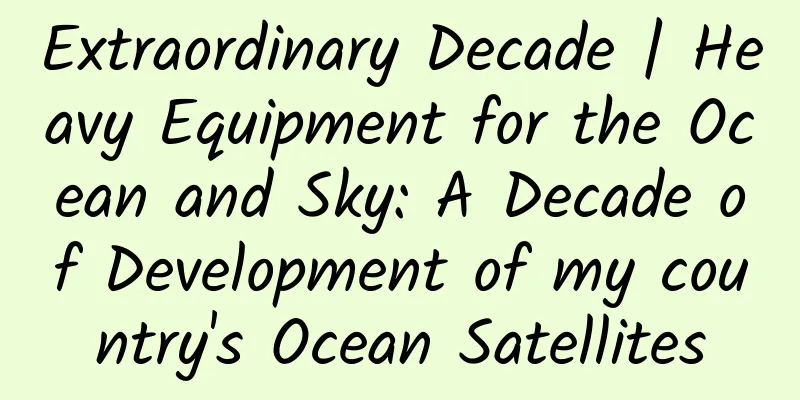Extraordinary Decade | Heavy Equipment for the Ocean and Sky: A Decade of Development of my country's Ocean Satellites

|
The ocean is a treasure trove of resources, an important transportation route, and a regulator of global climate change. Its strategic position in my country's economic and social development is becoming increasingly prominent. In 2002, with the successful launch of "Ocean No. 1", my country ended its history of not having ocean satellites and entered a new stage of space ocean remote sensing. "Understanding the ocean and managing the ocean are inseparable from ocean observation. Wind, waves, currents, tides, etc. require the help of ocean satellites to make precise analysis and judgments." said Lin Mingsen, Party Secretary and Director of the National Satellite Ocean Application Center of the Ministry of Natural Resources. Since the 18th National Congress of the Communist Party of China, my country has successively launched a number of ocean satellites, including Gaofen-3, Sino-French Ocean Satellite, Ocean No. 1C/D, and Ocean No. 2B/C/D, forming a multi-satellite networking and multi-station reception pattern. The monitoring range covers my country's land, sea, islands and reefs, as well as the polar regions and oceans. These ocean satellites, each with their own characteristics and complementary advantages, have formed three series of ocean satellite network observations and realized operational operations, supporting my country's ecological civilization construction, serving global climate change response, and providing corresponding guarantees for national security and the construction of the "Belt and Road" initiative... In addition, represented by the Sino-French ocean satellites, my country has carried out international cooperation with countries and regions such as Europe, ASEAN, and Africa, and provided large-scale and organized satellite remote sensing observation services. Constellation networking improves capabilities Liu Jianqiang, deputy director of the National Satellite Ocean Application Center, introduced that ocean satellites are designed according to the detection technology capabilities and characteristics of different elements, time and space resolution, coverage and monitoring frequency requirements, and are divided into three categories according to their uses, including ocean water color environment, ocean dynamic environment, ocean surveillance and monitoring series satellites. Ocean satellites cooperate with ocean stations, radars, buoys, seabed observation networks, volunteer ships, cross-section surveys and other means to continuously and long-term obtain global ocean ecological environment and dynamic environment parameters, and are an important part of the global ocean stereoscopic observation network. The Ocean Color Environment Satellite Series (also known as Ocean No. 1 series satellites) are used for ocean color, water temperature, and coastal zone observations. After Ocean No. 1A and Ocean No. 1B completed their missions, on September 7, 2018, the third satellite in the Ocean No. 1 series, Ocean No. 1C, was sent into orbit by the Long March 2C rocket, opening a new journey for the coordinated development of my country's natural resource satellites on land and at sea. On June 11, 2020, Ocean No. 1D was also successfully launched. The dual-satellite network is equipped with the same five payloads - ocean color and temperature scanner, coastal zone imager, ultraviolet imager, on-board calibration spectrometer, and ship automatic identification system, building my country's first marine business satellite constellation. Compared with Ocean No. 1A and B, Ocean No. 1C and D have greatly improved their observation accuracy, observation range and service life, realizing the upgrading of ocean water color observation capability. After the two satellites were networked for observation in the morning and afternoon, the observation capability was doubled compared with that of a single satellite, achieving the ability to observe the global ocean twice a day, and obtaining two global ocean water color and vegetation index remote sensing maps and four sea surface temperature products every day, greatly improving the effective observation capability of global ocean water color, coastal resources and ecological environment. Ocean No. 1 3D rendering (Image source: iNature All Media) The Ocean Dynamic Environment series of satellites (also known as Ocean-2 series satellites) are used to monitor a variety of ocean dynamic environment parameters such as sea surface wind field, wave height, sea surface height, sea surface temperature, etc. On May 19, 2021, Ocean-2D was successfully launched, and together with Ocean-2B and Ocean-2C already in orbit, it formed a "three-star network" to build my country's first ocean dynamic environment satellite constellation, achieving all-day, all-weather, high-precision observation of global sea surface height, effective wave height, sea surface wind field, and sea surface temperature, directly providing measured data for early warning and forecasting of disastrous sea conditions, and providing support services for marine disaster prevention and mitigation, marine rights and interests protection, marine resource development, marine environmental protection, marine scientific research, and national defense construction. Ocean No. 2 C/D rendering (Image source: iNature All Media) The ocean surveillance and monitoring satellite series (also known as the Gaofen-3 series of satellites) is used for all-weather global ocean and land information surveillance and monitoring. On April 7, 2022, my country successfully launched the Gaofen-3 03 satellite at the Jiuquan Satellite Launch Center using the Long March 4C carrier rocket. After the Gaofen-3 03 satellite was launched into orbit, it formed a network with the Gaofen-3 and Gaofen-3 02 satellites in orbit, marking the completion of my country's first ocean surveillance and monitoring radar satellite constellation. This series of satellites achieves a resolution of 1 meter and revisits some areas in 1 day. It is an important technical support for my country to implement marine development, conduct land environmental resource monitoring, and emergency disaster prevention and mitigation. It has enhanced my country's radar satellite sea and land observation capabilities, and provided strong guarantees and effective support for marine disaster prevention and mitigation, marine dynamic environment monitoring, marine scientific research, disaster reduction, land, environmental protection, water conservancy, agriculture, and meteorology. GF-3-02 (one-meter C-SAR) rendering (Image source: iNature All Media) Supporting the construction of ecological civilization Red tide is one of the main factors affecting my country's coastal marine ecology, and in severe cases it can even endanger human health. On February 14, 2021, the Ocean No. 1 C/D satellite captured large-scale red tides in the Beibu Gulf in the morning and afternoon respectively. On February 15, the South China Sea Bureau of the Ministry of Natural Resources and the Guangxi Satellite Application Technology Center of Natural Resources organized relevant units to conduct on-site verification and sent a monitoring team to patrol and collect samples in the waters west of Weizhou Island. The monitoring personnel concluded through experimental analysis that the abnormal area was affected by Noctiluca scintillans, and the concentration value reached the red tide warning concentration. Satellite monitoring and on-site investigations were coordinated and cooperated with each other, which made the red tide emergency monitoring and marine ecological environment early warning achieve good results. The linkage mechanism between the National Satellite Ocean Application Center, the South China Sea Bureau of the Ministry of Natural Resources, and the provincial satellite application technology centers has basically been formed. Such red tide monitoring is just one of many applications for ocean satellites. In summer, whenever a green tide of Enteromorpha occurs, the Ocean No. 1 series of satellites immediately conducts monitoring, which can not only identify the surface Enteromorpha, but also observe underwater information. Combined with the Gaofen-3 series of satellites and land satellites, it can realize daily monitoring of the Yellow Sea and the East China Sea, providing more effective and stronger support for the prevention and control of Enteromorpha. Whenever the severe cold weather hits in winter, sea ice appears in the Bohai Sea, sometimes hindering maritime transportation, sometimes affecting the production of offshore oil platforms, and sometimes affecting the safety of other structures. The Ocean No. 1 C/D satellite has become the main force for sea ice monitoring in the Bohai Sea, achieving a monitoring frequency of twice every three days and once a day in some areas, and providing thematic remote sensing products. As an ocean color satellite business satellite, the Ocean No. 1 series of satellites have shown their magical powers since they were put into orbit. Their five major payloads have been used to monitor the ecological environment of resources such as offshore aquaculture, offshore wind power, coral islands and reefs, mangroves, coastal wetlands, estuaries and harbors, reclamation, changes in the seawater inlets and outlets of nuclear power plants, internal waves, vortices, underwater topography, and land vegetation, lake ice, rapeseed, rice, black soil, desert, photovoltaic power generation, snow, glaciers, rivers and lakes. The data obtained have played an important role in the monitoring of disasters such as Bohai Sea ice, green tides in the Yellow Sea and East China Sea, near-shore red tides, oil spills, Antarctic and Arctic sea ice, iceberg drift, typhoons, lake blue-green algae, floods, forest fires, sandstorms, volcanic eruptions and pumice drift, making my country one of the international leaders in the field of ocean color remote sensing and providing a strong guarantee for the construction of ecological civilization in my country. Responding to marine disasters Every year, when typhoons occur frequently along the coast, bringing different degrees of danger and threats to coastal areas and people, ocean satellites immediately "prepare for battle" and enter a "combat" state. The Ocean No. 1 networking satellite can obtain the distribution and location of typhoons and cyclones around the world through relevant data and images, and the impact range and movement path of typhoon clouds can be obtained based on time series images. In combination with wind field data from the Ocean No. 2 and Sino-French ocean satellites, accurate information can be provided for marine disaster early warnings. In mid-July 2021, Typhoon Fireworks was formed in the waters east of Luzon Island in the Philippines. At 8:00 on July 19, the Central Meteorological Observatory upgraded Fireworks to a severe tropical storm. At 14:00 on July 20, the Central Meteorological Observatory upgraded Fireworks to a typhoon, and then to a strong typhoon the next morning. At that time, my country's coastal areas were on high alert. The Ocean-2B, C, D, and the Sino-French Ocean Satellite Network Ocean-1C and D immediately aimed at the "fireworks" and carried out continuous observations, locating the position and strength of the typhoon in real time, outlining the movement path of the typhoon, and providing timely data information for relevant national departments and coastal areas to effectively respond to the typhoon. "Fireworks" is huge and has plenty of water vapor. After landing in Zhejiang, it moved northward and affected Zhejiang, Shanghai, Jiangsu, Anhui, Shandong, Henan, Beijing, Tianjin, Hebei, Inner Mongolia, Liaoning, Jilin, Heilongjiang and other provinces (regions and cities). Ocean satellites continue to provide typhoon-related monitoring data and information to relevant departments and management agencies, providing effective services for marine disaster early warning and disaster prevention and mitigation. Zou Bin, director of the Science and International Cooperation Department of the National Satellite Ocean Application Center, said that similar marine satellite services for disaster prevention and reduction are everywhere. Multiple marine satellites in the space network have provided timely data support for emergency events such as floods in Henan, floods in Shanxi, fires in Yunnan, earthquakes in Qinghai, floods in Thailand, and the salvage of Enteromorpha. So far, ocean satellites have played an irreplaceable role in monitoring ecological and environmental factors and typical ecological disasters, and have achieved high-frequency, long-term global coverage monitoring of ecological factors such as ocean water color and water temperature. Ocean satellites monitor, discover and track typical marine ecological disasters such as green tides, red tides and oil spills in my country's waters in real time, obtain distribution information and grasp evolution trends, and provide key technical support for marine ecological disaster warning, prevention, control, disposal and assessment in the first place, providing accurate basic information for the analysis of marine ecological environment quality and the distribution pattern, status and evolution of marine ecosystems. Ocean Satellite Remote Sensing Application Services On April 27, 2021, the Panamanian cargo ship Yi Hai collided with the Liberian oil tanker Symphony in the waters near Qingdao, Shandong, causing damage to a cargo hold of the oil tanker and oil spills. The National Satellite Ocean Application Center immediately launched the emergency monitoring program, using domestic and foreign remote sensing data from satellites such as Gaofen-3 to conduct tracking and monitoring, and quickly provided data information and images such as the oil film distribution area, diffusion degree, and point coordinates to relevant departments, providing a decision-making basis for on-site pollution cleanup and accident disposal. The vast ocean is full of risks and there are often emergencies. Maritime target monitoring and emergency monitoring of production safety accidents are important aspects of ensuring marine safety. Lin Mingsen said that in order to better protect the safety of my country's maritime ships and oil platforms, safeguard marine rights and interests, and respond to global climate change, when planning and designing ocean satellites, full consideration was given to providing major national strategic support. Since the 18th National Congress of the Communist Party of China, the GF-3, GF-32 and GF-33 satellites have formed a constellation and networked into a series of ocean surveillance and monitoring satellites. The "SAR and AIS Joint Maritime Target Surveillance and Monitoring System" (SAR is synthetic aperture radar, AIS is automatic ship identification system) developed on this basis has provided important information and data support for the safety of my country's maritime ships and oil platforms, the protection of maritime rights and interests, and the response to global climate change. In terms of maintaining marine rights and interests, the monitoring data of artificial facilities on islands and reefs, offshore ships, and offshore oil and gas platforms acquired by ocean satellites provide information services and auxiliary decision-making support for maintaining marine rights and interests. In terms of comprehensive marine management, ocean satellites provide important objective basis for comprehensive coastal management and marine use management by acquiring monitoring data such as coastal changes, coastal geology and ecological environment, coastal artificial facilities, and functional zoning of sea areas. The high-resolution ocean waves, sea surface wind fields, shallow underwater topography, mesoscale eddies and front data acquired by ocean satellites provide support for global ocean dynamic environment research and carry out marine environmental monitoring for the demonstration and operation of coastal nuclear power plants and major overseas projects. Ocean satellites conduct remote sensing monitoring for polar scientific expeditions and polar routes, build a polar satellite remote sensing monitoring system, serve the safety and security of polar routes and global climate change response; actively carry out satellite remote sensing monitoring of ocean contract areas, implement global sea level and seabed topography monitoring, and provide monthly environmental monitoring reports. These have contributed important data and information support to the development of deep sea and polar regions. In addition, ocean satellites have been used in many routine and emergency tasks, including monitoring illegal fishing vessels at sea during the summer fishing moratorium, emergency monitoring of key ships, information monitoring of ships operating in my country's international seabed contract mining areas, and monitoring of offshore oil and gas platforms. Serving the Belt and Road Initiative In 2018, an ocean satellite jointly developed by China and France touched the hearts of the people of the two countries. This satellite is the Sino-French Ocean Satellite, which was successfully launched at 8:43 on October 29 at the Jiuquan Satellite Launch Center. This is not only the first satellite jointly developed by my country and France, but also the first time in the history of China's aerospace and oceanography that it has carried out system-level and full-process cooperation with an advanced aerospace country. Liu Jianqiang introduced that the scientific researchers from China and France realized that cooperative development is an inevitable trend for the common progress of mankind. During the development process, the two sides conducted many tests and solved many problems. The Sino-French ocean satellite has achieved for the first time large-scale, continuous and synchronous observation of the directional spectrum of waves and sea surface wind fields on a global scale. The scientific data are collaboratively acquired, processed, published and backed up by the two sides' ground receiving stations and data centers. China-France ocean satellite renderings (Image source: iNature All Media) In February 2020, China and France announced that their ocean satellite data would be open to the world. Over the past two years, 1,099 scientific research teams from 75 countries and regions, including France, China, Germany, the United Kingdom, Spain, the United States, Russia, India, Japan, Australia, and South Africa, have used the satellite data for scientific research and business applications. Castien, satellite project manager at the French National Center for Space Studies, said: "China and France have joined hands for the first time, and both have learned a lot from each other. This is a win-win cooperation, and both sides will become richer." The successful implementation of the Sino-French ocean satellite project demonstrates the practical actions and practical explorations of the two countries to jointly respond to global climate change and disaster prevention and reduction, and to build a "community of shared future for mankind" and a "community of shared future for the ocean". Since then, my country's ocean satellites have further stepped onto the stage of international cooperation and served the construction of the "Belt and Road"... Many aspects have blossomed and achieved remarkable results: participating in the application and approval of the United Nations "Ocean Decade" Ocean and Climate Collaboration Center; signing a memorandum of understanding on satellite data application cooperation with the Argentine Space Activities Commission, and continuously providing Argentina with Ocean-2 satellite data; participating in the construction of the China-ASEAN Marine Science and Technology Research and Development Center, the China-ASEAN Satellite Center, and the China-Africa Satellite Center; deepening the data exchange with the European Meteorological Satellite Organization, the landing reception of Ocean-2 satellite data and scientific cooperation, etc. Satellites overlook the earth, and the ocean connects the world. From 2002 to 2022, 20 years of hard work have built a system; from 2012 to 2022, ten years have passed and nine satellites have been networked. Economic and social development requires ocean satellites, and monitoring the changing situation at sea is inseparable from ocean satellites. At present, Ocean No. 1E and the ocean salinity detection satellite are under development. During the 14th Five-Year Plan period, four operational satellites are included in the plan and are waiting for project approval. In addition, three satellites, including a new generation of polar-orbit ocean power, high-orbit ocean coastal surveillance and monitoring, and high-orbit microwave remote sensing satellites, are carrying out key technology research. Lin Mingsen said that the ocean is the cradle of life and the home of wind and rain. To understand and manage the ocean, we cannot do without ocean satellites. As my country's strategy of building a strong maritime nation continues to deepen, ocean satellites will surely be better applied to serve various fields of economic and social development and the construction of a strong maritime nation. Surveying the sky and the sea, holding important tools, managing the vast blue sky and striving for strength. |
<<: From Shenzhou V to Shenzhou XV, there is a kind of struggle called Chinese spaceflight!
Recommend
Do you know these 4 points about Tencent social advertising?
Do you know all this about Tencent social adverti...
How did Nokia, which was ruined by the Americans, rise from the ashes?
Recently, there have been more and more rumors ab...
"Hand in hand" in outer space? A review of the "highlights" of China's international space cooperation
After decades of efforts, China's space indus...
How can enterprises promote themselves well?
How can enterprises do a good job of promoting th...
Domestic mobile phones are competing overseas. If they continue to sell at low prices, they may die?
On April 6, Canalys Market Research and Sina Weib...
Pilots are not allowed to have scars, but why can injured pilots continue to fly?
As we all know, the medical examination for pilot...
As early as more than 70 years ago, Hainanese people achieved "coffee freedom"?
People who come to Hainan, in addition to enjoyin...
Control Cat Short-term Basic Training Camp, Control Cat Double Plan
Introduction to the resources of the Kongpanmao s...
Creative interpretation and placement strategies of WeChat Moments advertising cases
There are two types of advertisements for WeChat ...
This "little superman" among animals can actually stack physical and chemical buffs when facing enemies
In nature, all kinds of animals have evolved diff...
Come, count how many birds are there in this picture?
Not long ago, Guokr held a Youth Forum with the t...
iOS14.7 official version released! Battery life extended, heating issues significantly improved
[[412242]] Just this morning, Apple officially pu...
The successful development of the mobile phone self-destruct function actually solved Ma Huateng's concerns 6 years ago
Nowadays, mobile phones have already become an in...
Do people with photographic memories really exist?
© Genetic Literacy Project Leviathan Press: The w...
Download the free software of Big Pineapple Fujian Navigation and download the dirty APP of Big Pineapple Fujian Navigation!
The online entrance of Da Pineapple Fujian Naviga...









